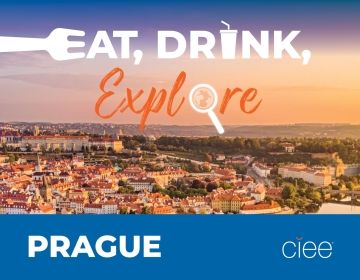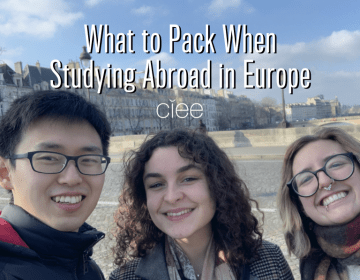Study Abroad Spotlight: CIEE & UCEAP Prague
The program
The CIEE program is located in a former remodeled church on the top of Vysehrad, so get ready for some toned legs and a beautiful view everytime you go to class. It’s a big program, with over 200 students every semester. Since most of the classes are taken through CIEE, you mostly interact with American students. I didn’t meet many Czech locals, but it was a great opportunity to meet people from all over the United States. (This program is quite possibly the first time I interacted with someone from the Midwest.) The school is located in a refurbished chapel on Vysehrad, a historic fort at the top of a hill. It had a gorgeous view of the city skyline and also really long, steep stairs, so I like to think my legs got really toned at the end of the program.
The country
Prague is a gorgeous city miraculously preserved in a medieval bubble. Full of Gothic architecture and modern art, you can spend hours just walking around the city. The city has a dichotomy of being seeped in both medieval and modern history. One of the best tips I got before I left was to look up all the time because there is so much public art installed everywhere, especially at the top of buildings. My favorite was the giant fly in the corner of a building, see if you can spot it!
Prague’s main public transportation systems are trams and the metro, both of which are very easy to get the hang of and come very often — public transportation here is so reliable! Everyone warned us that Prague citizens may come off as rude or blunt, as they usually don’t smile on the streets or make small talk, and I would generally agree but also note that it was never too off-putting. I never felt unwelcomed, everyone just kept to themselves. There were only a handful of genuinely rude encounters, but really, you can have a rude encounter anywhere. And the socially awkward side of me loved that I didn’t have to smile at everyone I made eye contact with on the trams.
The housing
With this program, you have four choices of housing: residencies, apartments, homestays or dorms. I lived in a residency, which are buildings where everyone living in them is a CIEE student. (I really enjoyed it and would recommend it, as most of my friends came from the building.) In the apartments, only a few of the rooms were occupied by students — the rest were inhabited by local Prague citizens. People who lived in apartments also got Czech buddies that lived with them, so my friends in apartments got to know the locals better than I did! If you picked a homestay, you could live with a local family or citizen — these seemed immersive but also made it hard to meet other students. Dorms were similar to residencies except that they didn’t have kitchens. Not many people were fans of the dorms, but they were only a few minutes walk from the school.
The food
Czech food is hearty and meaty! Staples include goulash, bread dumplings and fried cheese. There are a million booths that sell “trdelník,” cones of cinnamon sugar-coated bread, but these tasty treats actually come from Hungary and only popped up recently in Prague as tourist traps. As a vegetarian, I was nervous about going to Prague, but the city has so many international cuisines and an oddly large number of Asian vegetarian restaurants. Any craving you had could be fulfilled here — I had everything from Thai food to Mexican food. There were even a few restaurants selling vegetarian Czech food, so I was still able to try classic Czech cuisine.
Czech cafe culture seems huge here! There are so many hip and trendy cafes that would make LA jealous. The best part was that since everything was cheaper here, you could ball out on a cool drink, trendy brunch and delicious dessert all for the price of an entree in the US. There were some cafes that seemed to discourage students hole-ing up and studying all day, but on the flip side there were also cafes dedicated for students— although sometimes they filled up very fast!
You can’t mention Czech cuisine without mentioning beer, which is basically a bigger staple than water. Everywhere you go served beer— cafes, restaurants, book stores, I even saw a few barbershops that offered beer. Pilsner Urquell is the big one, but other big names included Kozell, Radegast and Krusovice. This is almost blasphemous of me, but I’m not a big beer person and thankfully Prague is also really big with ciders and have a large selection of flavors that I’ve never seen in the US. (My apartment’s fridge was always stocked with Elderflower cider, which is the most European thing I can think of.)
The academics
The classes in the CIEE building are relatively small, and the ones I had were very rooted in discussion and presentations. There were definitely some classes that were harder than others, but none were too overwhelming— I still traveled most weekends and had plenty of time to do my work on the weekdays. The only caveat was that the attendance policy was very strict — if you had more than two absences, your grade would go down a letter grade. The program also offered classes through Prague’s Film and TV School of the Academy of Performing Arts (FAMU) or at Charles University. I took as many classes as I could at FAMU, which was much more lenient with its attendance policies. The FAMU classes that were offered to us were part of the FAMU International program, which meant the classes I took were filled with students from all around the world, ironically except the Czech Republic since those students took regular FAMU classes.
The FAMU building is amazing! With its building located right on the river, you could get a view of the Charles Bridge and the water in most of the classrooms. They have a bar/cafe/underground music venue in the basement of their building, which is the artsiest thing I can think of for a film school. With the classes, you get what you put into it, which means you could still coast by pass but never learn anything or put work into it and take advantage of what the teachers have to offer.
The traveling
Prague really is in the heart of Europe, making it easy to visit a lot of countries. Budapest and Vienna are must-sees, and I would also recommend visiting places that aren’t conventional European travel spots, as it will never be cheaper to visit them than when you’re in Prague. While Vienna was my favorite city I visited, Krakow was unexpectedly my favorite trip, which is partially due to my new found love of pierogies and because I didn’t expect Poland to have so many beautiful places. I also took a solo trip (which I highly recommend) to Trieste in Northern Italy, which was really cool because it’s not a normal tourist spot.
Traveling by bus is usually the cheapest way to get around, unless you snagged a flight during a good deal. A pro tip is to use Google Flights to explore how much flights are around Europe for a specific weekend and then put the max price at $100. Then, you can click through each weekend to see what deals are offered where. There are also many great cities within the Czech Republic to visit! CIEE offered free weekend excursions to many of these cities, which are a great opportunities to take advantage of.
Related Posts

EAT, DRINK, EXPLORE: PRAGUE
BEST FOOD TO EAT IN PRAGUE One of my fondest memories of Prague is a meal I had in the Old Town Square. In fact, I was so enthralled, I... keep reading

What to Pack When Studying Abroad in Europe
It's crucial to pack the right things to study abroad so you can enjoy a successful and stress-free experience. It goes beyond just having clothes and toiletries. Forgetting any key... keep reading

5 Best Places to Study Abroad for Psychology
If you’re studying psychology , or if you’re passionate about the field, consider studying psychology abroad to learn all about this fascinating discipline from another country’s perspective. Perhaps you're a... keep reading